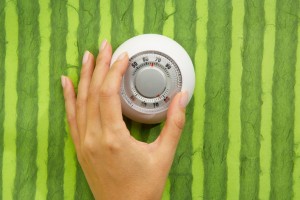 When you think about cooling down your house with an air conditioner, do you imagine the AC blowing cool that pushes the hot air outside? It doesn’t quite work like that. The air conditioner actually turns the warm air in the house into cool air by drawing the thermal energy out of along the cooling coils, then blowing this cooled air into the rooms of the house.
When you think about cooling down your house with an air conditioner, do you imagine the AC blowing cool that pushes the hot air outside? It doesn’t quite work like that. The air conditioner actually turns the warm air in the house into cool air by drawing the thermal energy out of along the cooling coils, then blowing this cooled air into the rooms of the house.
Heat Moves to Where You Don’t Want It
But having cool air in your home doesn’t keep the heat outside—not completely. Heat naturally moves from an area of high concentration to one of low concentration. Any time your home’s interior has a lower temperature than the exterior, the home will experience heat gain as the heat energy seeps inside wherever it can. Insulation, air sealing, and closed doors and windows slow down heat gain, which is why insulation is helpful in summer as well. But there’s no way to stop all heat gain.
It might be easier for you to think of the situation in the opposite way. During winter, your house will experience heat loss as the warmth inside escapes to the outside. You experience this any time you open a door to the outside and feel the heat rapidly vanish. Insulation helps slow this down as well.
What This Has to Do With the Thermostat
If you’re wondering why heat gain and heat loss have any connection to your home’s thermostat, the answer is that understanding this process helps to understand how best to set the thermostat for maximum energy conservation coupled with comfort.
We mentioned that insulation slows down heat gain in a house. But what also slows down heat gain is raising the temperature indoors to be closer to the temperature outdoors. Heat moves slower between two areas when there is a narrow difference in temperatures in the zones. For example, if you could somehow cool your house down to 30°F (you can’t, and be thankful) when the outdoor temperature is 110°F, what would it feel like to open a door? A fast and hard blast of heat, that’s what. Heat gain is fast when the temperature difference is that great. When the difference is less, heat gain is less.
Now we’ll look at this in practical use. If the temperature outdoors is 85°F, keeping the thermostat down at 68°F allows the outdoor heat to move indoors much faster than if the thermostat was set at 78°F. The lower setting means your home gets hotter, faster, and that in turn means the air conditioner must run longer. At 78°F, which is still comfortable for most people, the heat gain will be much slower and the AC will have a far easier time keeping up with comfort requirements. It’s not just that it’s aiming for a higher temperature, it’s also that the house warms up slower.
The same advice applies in winter, only flipped around: you want to keep the thermostat down to a lower but still comfortable temperature so the heat inside won’t escape too fast.
If you are looking for quality air conditioning service in Fairfield, OH or the surrounding areas, call us to schedule the work.
“For a Comfortable Way of Life,” call Bartels Heating & Cooling.
